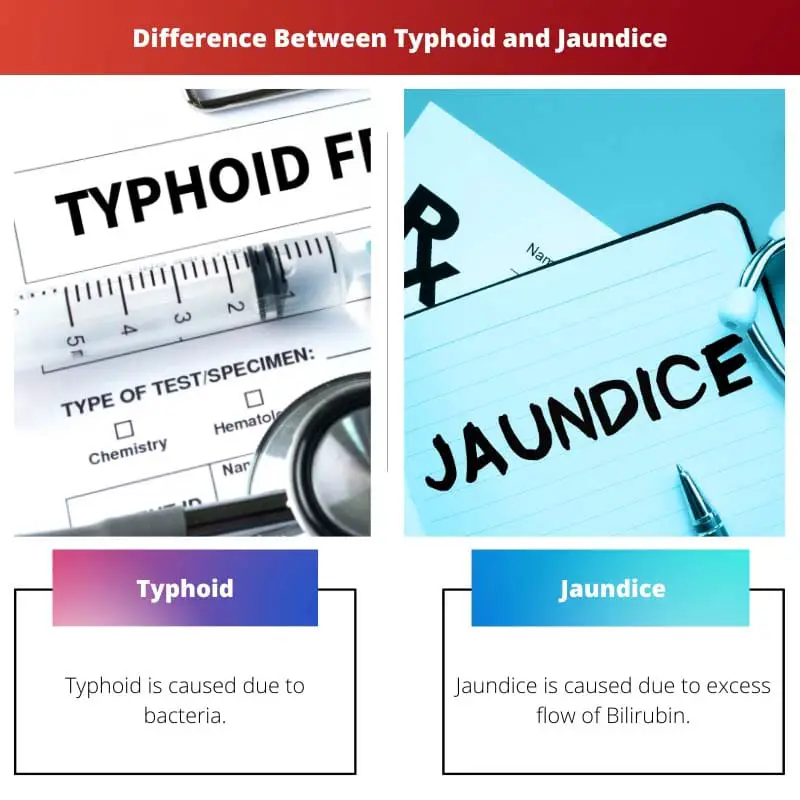There are a lot of diseases that can cause serious trouble. Some of the sicknesses are caused by bacteria and viruses. Typhoid and jaundice are two health diseases that can cause severe problems to the body.
Typhoid is different from jaundice. This health disease is dangerous but this can be cured with proper medications.
Key Takeaways
- Typhoid is a bacterial infection caused by Salmonella Typhi, whereas jaundice is a symptom resulting from an accumulation of bilirubin in the body, due to liver dysfunction.
- Typhoid symptoms include fever, headache, and fatigue, while jaundice is characterized by yellowing of the skin and eyes, dark urine, and pale stools.
- Treatment for typhoid involves antibiotics, while jaundice treatment depends on the underlying cause, including medications, lifestyle changes, or medical procedures.
Typhoid vs Jaundice
Typhoid is caused by the bacterium Salmonella typhi, which is contracted by consuming contaminated food or water. Jaundice is not a disease itself, but a symptom of an underlying condition that makes the eye yellowish. Typhoid is contagious, while jaundice itself is not contagious.

Typhoid is spread due to polluted water and food. Eating and drinking which is contaminated. Typhoid can have a severe fever, headaches, and other weaknesses.
Typhoid is mainly caused due to a bacteria which is called Salmonella Typhi. Typhoid affects the multiple organs of the body. It can damage the organs and makes them weak.
Jaundice is spread due to bilirubin in the blood. Jaundice can have a severe fever, chills, and abdominal pain. Jaundice is mainly caused due to excess bilirubin in the blood flow.
It can damage the skin and makes the body weak. The skin will go yellow also the blood flow will be reduced in the body.
Comparison Table
| Parameters of Comparison | Typhoid | Jaundice |
|---|---|---|
| Definition | Typhoid is caused due to bacteria. | Jaundice is caused due to excess flow of Bilirubin. |
| Symptoms | Severe fever, weakness, and headache. | Yellow skin, high fever, and weakness. |
| Affects | Typhoid affects the organs. | Jaundice affects the skin. |
| Treatment | Antibiotics and some fluids. | Dehydration and phototherapy for babies |
| Prevention | Clean water and clean food. | Maintaining a healthy body weight. |
What is Typhoid?
Typhoid is a disease which is caused due to bacteria which is known as Salmonella typhimurium. The bacteria can cause high fever, vomiting, and also severe headache.
Typhoid can cause death if not treated properly. The disease can travel from one place to another through contaminated food and water.
Polluted water and food can cause food poison which might lead to typhoid. Washing hands is a good habit. Typhoid is prevalent in places where washing hands is less.
Salmonella typhimurium is present in the human body. This bacterial case is very much seen in low-income countries. Around 27 percent of patients are seen in low-income countries.
Some countries have no proper treatment facilities. Typhoid does not only include high fever as it also includes some gastrointestinal.
There are people with high white blood cells. People can carry the bacteria without any symptoms. The majority of the patients are found in the united states of America.
Although the patients are contracted overseas. Treatment for typhoid is antibiotics, as well as some, can be cured by fluids. Animals cannot have typhoid.
Bacteria are transmitted through humans. If typhoid is looked at carefully then it won’t be fatal. But if the treatment is not good then it would be deadly.
Typhoid can be a communicable disease. It can cause fatal problems if not treated properly. People have contact in many ways as well as everyone should be hygienic to stay safe from this type of bacteria.

What is Jaundice?
Jaundice is a disease that can turn your skin, eye whites, and also mucus to yellow. It happens because of the rise of bilirubin in the blood.
The yellow pigment is called the bilirubin that increases in the bloodstream. Jaundice can occur due to many reasons. There are different reasons.
Also, jaundice is dissimilar for adults and for babies. The bile fluid is present in your liver. The liver produces an excess amount of bile fluid then which can cause jaundice.
Breaking down red blood cells in your body can increase the bile fluid. The symptoms are common in everyone. The skin turns yellow as well as the body feels weak.
Some people find the indications accidentally. The seriousness of the disease depends on the development and also the causes.
Fever, chills, abdominal pain, and color change of the skin are common symptoms for adults. It is not necessary to have jaundice through bilirubin. Jaundice can also happen due to infection.
Weight loss and itchy skin can also lead to jaundice. Abdominal pain is caused during jaundice because of pancreatic and biliary cancer.
Liver disease can also cause jaundice. The increase of red blood cells in the body can also prevent you from jaundice. Jaundice is not a communicable disease.
But a proper treatment should be there to help it cure the disease. Jaundice can be fatal for newborn babies. Adults do not have severe symptoms. Jaundice can be intercepted through fluids.
Main Differences Between Typhoid and Jaundice
- The main difference between typhoid and jaundice is that typhoid is caused due to bacteria. But, jaundice is caused due to rise of bilirubin in red blood cells.
- Another difference is that typhoid can transmit from humans to humans. But jaundice does not communicate through human-to-human contact.
- The other difference is that typhoid has to be treated immediately with proper treatment. On the other hand, jaundice does not need immediate treatment.
- Another difference is that typhoid can be prevented through clean water and food. Jaundice can be prevented by keeping the body weight balanced.
- Another difference is that typhoid affects the organs severely. Jaundice affects the skin rather than the organs.





